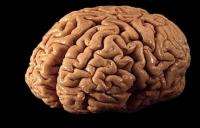(PhysOrg.com) -- The pulsing of a single neuron can switch a brain’s waves from the equivalent of a big ocean swell to ripples on a pond, according to new research from Howard Hughes Medical Institute investigator Yang Dan of the University of California, Berkeley.
The study reveals important new information about how the brain controls large-scale activity patterns and suggests that an individual cell has more influence than previously thought. The findings, published in the May 1, 2009, issue of the journal Science, could ultimately shed light on how chaotic brain patterns can lead to sleep disorders such as sleepwalking.
Brain cells use electrical pulses to talk with one another and guide functions ranging from heart rate and breathing to decision-making and navigation. Like the din of a crowd, the chatter of 100 billion neuronal cells in the human brain creates larger patterns of activity commonly called brain waves.
These patterns reveal the brain’s general state of arousal. For instance, large, slow brain waves that are synchronized throughout the brain are indicative of deep sleep. “Many neurons are doing the same thing at the same time,” says Dan. During so-called rapid eye movement (REM) sleep, on the other hand, different brain areas are less synchronized, firing in smaller and more frequent oscillations. And in an awake person, the brain broadcasts a rapid, uncoordinated pattern.
Dan and her colleagues wanted to understand how large-scale wave patterns influence the connection between two neurons. They knew that neuronal connections could strengthen or weaken over time, and these changes seem to underlie learning and memory. They wondered whether the overall pattern of brain activity altered nerve cells’ ability to change their connection strength.
Studying anesthetized rats, they used one electrode to spur a neuron to fire rapidly and used another electrode nearby to activate the local neuronal connections. A third electrode was used to pick up the larger pattern emitted by all the neurons in the area. They wanted the overall brain state to remain constant during the experiment, but instead found that tickling one neuron could cause the entire brain state to change.
“Initially, this was very inconvenient,” says Dan. But then the researchers realized that the phenomenon deserved more attention. Looking more closely, they verified that a neuron firing at high frequency could switch the brain from a “non-REM pattern” of activity to a “REM pattern,” and vice versa.
The result was counterintuitive. “Every neuron makes connections to roughly 1,000 other neurons, but most of those are quite weak,” says Dan. A target cell won’t respond unless many, many neurons that connect to it fire at the same time and therefore she says it’s surprising that a single neuron could change the activity of the whole brain. “Single neurons have more weight than we used to think,” she says.
Dan doesn’t yet know how one cell could exert such power. The researchers had to repeatedly and rapidly fire a cell to cause the pattern to switch, so they might be emulating the effect of many cells firing at once. A neuron doesn’t normally fire in that way, so it is an open question whether the activity of a single neuron could change overall brain pattern under normal circumstances.
The findings add a new twist to how brain patterns are established. Researchers know that certain brain structures, such as the hypothalamus and the brain stem, play a part in setting the pace of global brain activity. In this study, Dan and her team were tickling brain cells in a different area: the cortex, the thin sheet of neurons on the surface of the brain involved in such abilities as moving and seeing.
Dan isn’t certain how cells in the cortex might control brain state, but she posits that signaling there could link back to the thalamus and spur it to set up a new pattern. “We know that a lot of circuits are involved in controlling brain state,” says Dan. “We’re saying that cortex is also part of that loop.”
By providing new information about how brain states are controlled, the study might ultimately lead to new knowledge about what causes certain sleep disorders. “In sleepwalking, there is a mixed-up boundary between slow-wave sleep and the awake state,” says Dan. “Your muscles move, but you aren’t consciously aware of your surroundings.” Understanding the circuitry that establishes brain states could ultimately reveal how that mixed-up situation is established.
Next, Dan wants to study animals that are naturally awake or sleeping, rather than anesthetized, to see if under normal conditions, a single neuron or a few neurons really can turn the tide on the entire brain.
Provided by Howard Hughes Medical Institute (news : web)



















